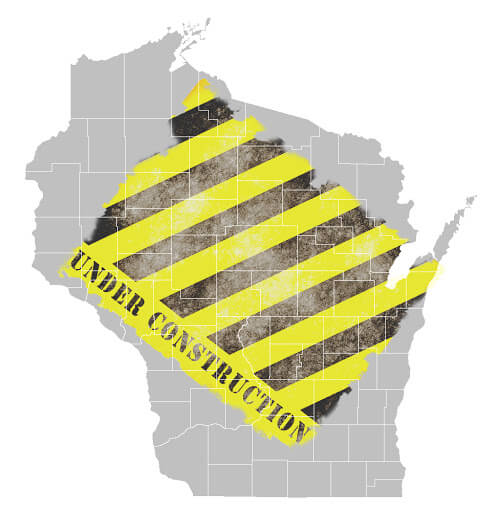
Wisconsin: Union Busting, or Punishing PLAs?
by Chuck Rehdorf on 2017-10-18 11:26am

Image credit: atyourpaceonline
In a nation in which states pride themselves on each being unique, Wisconsin is as unique as they get. From hundreds of miles of river and lake shoreline, to a major city whose history includes the Bridge War that led to the creation of Milwaukee, it is a place where some of the rugged individualists appear to still live. And if you are a Wisconsin contractor or construction worker and you want to work, there’s probably a place for you here, whether you belong to a union or not.
In April 2017, Governor Scott Walker signed into law a bill that now prohibits state and local governments from requiring a bidder on public works projects to enter into agreements with labor organizations. The same bill, Senate Bill 3, also prohibits those same state and local governments from considering whether or not a bidder has entered into a labor agreement as a deciding factor when awarding a project.
At the heart of the matter here are what are known as Project Labor Agreements (PLA), and depending upon where you’re standing, they are either a way of keeping work on time and on budget and providing good representation for their workers, or they are keeping smaller contractors and non-union employees from participation in lucrative public works contracts.
PLAs have been around for quite a while, having originated during the Great Depression, but like everything else in this media exposed age, they are emerging from the murky shadows of legislative and big-labor backroom secret handshakes and disappearing-ink scheming, into an abruptly harsher public light, with people landing on both sides of the issue.
Those in favor of Project Labor Agreements say they perform wonders like providing stable, more enhanced wages and benefits for workers. The gains far outweigh any negative implications, they say. Even the contractors reap the rewards, in the form of a reliable and uninterrupted supply of qualified workers. They may even have clauses that provide for continued training or apprenticeship programs.

Image courtesy of: wikimedia commons
Those who sing the praises of PLAs also say that even the taxpayers see the benefits, in the reduction of safety issues on the job and things like consolidation of several different unions into one PLA, creating fewer different wage and benefit structures, thereby saving taxpayer dollars. Many say the greatest benefit is that more construction wages stay in a state or locality and that there is less misclassification of workers and the subsequent underpayment of payroll taxes and workers compensation. Some might ask with a foundation like that, how come the building still doesn’t look right? There might be more to it than that. Which is why Scott Walker took a big step toward putting the leash on unions and PLAs.
Some of the stated disadvantages of PLAs are that they significantly increase costs across the board, by fixing union wages and work rules. Most detractors say the greatest disadvantage though is that they stifle competition and are inherently unfair to nonunion companies and nonunion workers.
In 2009, President Barack Obama signed a legislative order that ‘encouraged’ federal agencies to “consider” requiring the use of a PLA in any large scale construction project over $25 million. The ‘encouragement’ went into effect in 2010.
Right into the middle of that stepped Republican Governor Scott Walker, who has since been vilified as a “union buster” by some of the biggest names in Union-dom. In 2015, AFL-CIO President Richard Trumka issued a statement when it was revealed that Walker was going to announce his run for the presidency. The statement was simply,”Scott Walker is a national disgrace.” Succinct and unequivocal, if not poetic. Remember though, that Walker is a Republican Governor in a state that gave Barack Obama the presidential nod… twice. Maybe Walker has more of a constituency than some might have thought, or hoped.
When Walker signed the bill in January, the reception in the city of Milwaukee was also, well, chilly. Referring to the benefits of PLAs, Mayor Tom Barrett said, “These types of agreements can enable costs to be more tightly controlled and ensure that there are no disruptions to the construction schedule, for example from strikes. These factors far outweigh the unproven assertion that PLAs drive up project costs.”
As far as what Barrett referred to as an unproven assertion goes, the honorable mayor might be wrong about it being unproven. In a May 2017 study by the Beacon Hill Institute, a definite correlation was shown between PLAs and higher costs on public school construction in the state of Ohio. In fact, that higher cost was somewhere in the neighborhood of over 13 percent.
Within the same study, the authors cited figures that showed higher construction costs under PLAs in states that included Massachusetts, New York, New Jersey, and California, with those figures staying in that 13 percent higher range.
In their own study, the state of New Jersey found that jobs under PLA contracts not only cost more and took longer, but they also found that there was not a significant difference in the number of minority workers hired. So what is all of this saying for the construction industry and construction workers in Wisconsin today?
Well, one thing it definitely seems to be saying is that workers in Wisconsin are finding less reason to be involved in unions. According to the United States Bureau of Labor Statistics, the number of workers belonging to a union has been declining nationally for the last ten years or so, and Wisconsin is one of the leaders in that trend. Could it be that everyone from your average citizen to our governments are beginning to think unions have outlived their usefulness? Now that we have federal and state work standards concerning virtually every aspect of the work environment, (safety, wage, harassment, training) has the time for unions come and gone?
First of all, it might not be that simple. There are still industries and circumstances where unions provide invaluable services to their members. They are some of the greatest sources for thorough, standardized training for advancement in a profession, and many of them provide outstanding wage and benefit packages for their members as well. So it might not be appropriate to hope for their demise so quickly.
PLAs though, might not be as easy to throw a positive spin on. At their very best, Project Labor Agreements lock government entities into agreements that might only be advantageous for unions themselves, leaving poor taxpayers out in the cold. Where they might have been useful in the Great Depression as a tool to get our population working again, they may now instead be nothing but a speed bump in getting large public works contracts from the drawing board to the opening of their doors in the shortest amount of time with the least amount of digging into taxpayer pockets.
While most experts agree that finding conclusive evidence of the effectiveness of a PLA may be difficult, finding instances of their costs are easy to locate.
In the same article wherein Mayor Barrett was quoted as saying that the disadvantages of PLAs could not be proven, he said, "Hiring a well-trained, high quality workforce is a priority for me."
If that’s indeed the case, wouldn’t it apply to non-union workers as equally as their union counterparts? If we were talking strictly about the most qualified workers, wouldn’t a PLA be as likely to inhibit that as to promote it? In the end, there may have been a place for PLAs once, but in today’s construction market, from Kenosha to Solon Springs, maybe construction workers are better without them.